|
Tule
Ponds at Tyson
ZOOPLANKTON |
 |
|
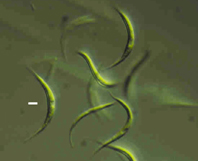 Closterium (Closterium
sp.) Closterium (Closterium
sp.)
Green algae, planktonic (floater)
Family Desmidiaceae.
White scale bar is 5 microns.
Cells curved
(crescent-shaped), rarely straight, with or without median
constriction. End of cells vary, pointed, blunted, or rounded. Cell
wall smooth with little ornamentation; longitudinal striations.
Pigments green, occasionally yellow-green.
Cell diameter: 16 - 75 x Length: 100 - 800 microns |
|
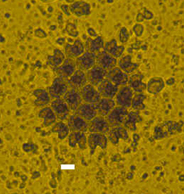 Pediastrum (Pediastrum
sp.) Pediastrum (Pediastrum
sp.)
Green algae, planktonic (floater)
Family Desmidiaceae.
White scale bar is 5 microns.
Free-floating
colony of plate-like cells in the interior and exterior cells with
one or two spines. The number of cells often times is
characteristics of the species. Cell walls resistant to decay and
many species are found in fossil condition. Cell wall may be smooth
or granulated. Colony size is up to 40 microns. |
|
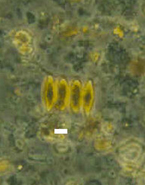 Scenedesmus(Scenedusmus sp.) Scenedesmus(Scenedusmus sp.)
Green algae, colonial, planktonic (floater) and/or periphytonic
(attached)
Family Scenedesmmaceae.
White scale bar is 5 microns.
Colony usually
of four cells, the two inner cells are oval to box-shaped, whereas
the two outer cells have spines and may be crescent-shaped.
Occasionally, some colonies maybe found with 12 or more cells Cell
length 12.5 microns, width 5 microns. |
|
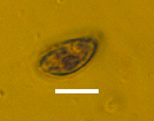 Chroomonas(Chroomonas
sp.) Chroomonas(Chroomonas
sp.)
Planktonic (floater, able to propel itself in the water column)
Family Cryptochrysidaceae
White scale bar is 5 microns
Tear-drop shaped
cells with two unequal lengthen flagella are attached towards the
pointed end of the cell. Flagella two to three times length of cell.
Eyespot may be present, two or three blue-green to bluish
chloroplast bodies may be present. Cell length 13, width 7 microns.
|
|
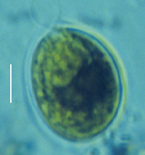 Chlamydomonas (Chlamydomonas
sp.) Chlamydomonas (Chlamydomonas
sp.)
Flagellate. Planktonic (floater, able to propel itself in the water
column)
Order Family Chlamydomonadaceae.
White scale bar is 5 microns
Cells round to
oval in shape, with one cup-shaped chloroplast and one or more
chloroplastid body. Eye-spot may be present. Two flagella usually of
equal length, attached in the cup-shaped chloroplast area. Cell
usually covered in a clear to semi clear gelatinous-like layer. Some
500 plus species have been identified. Cell diameter 5 to 10
microns. |
|
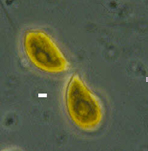 Phacus (Phacus sp.) Phacus (Phacus sp.)
Flagellate. Planktonic (floater, able to propel itself in the water
column) or periphytonic (attached)
Family Euglenaceae.
White scale bar is 5 microns
Solitary
free-swimming. Cell top-shaped with a longitudinal spiral with a
rigid shape. Cell wall often with dot-like ornamentation arranged in
the longitudinal axis. Single flagella attached in a gullet at the
rounded end of the cell. One or two ring-like bodies located within
the center of the cell. Eyespot may be present in some species.
|
|
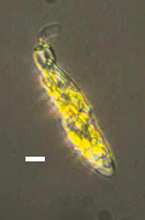 Euglenoid (Eutreptia sp.) Euglenoid (Eutreptia sp.)
Flagellate. Planktonic (floater, able to propel itself in the water
column)
Family Euglenaceae.
White scale bar is 5 microns
Cell shape
variable, though usually an elongated tear-drop to pear-shaped to
stubby pencil-shaped. Cell wall ornamented with small dot-like lines
arranged length-wise to cell body, though spirally twisted. Two
equal lengthen flagella attached at the rounded end of the cell, in
the area of the gullet. Gullet is generally present; as are
vacuoles. Cell diameter 23, length 178 microns. |
|